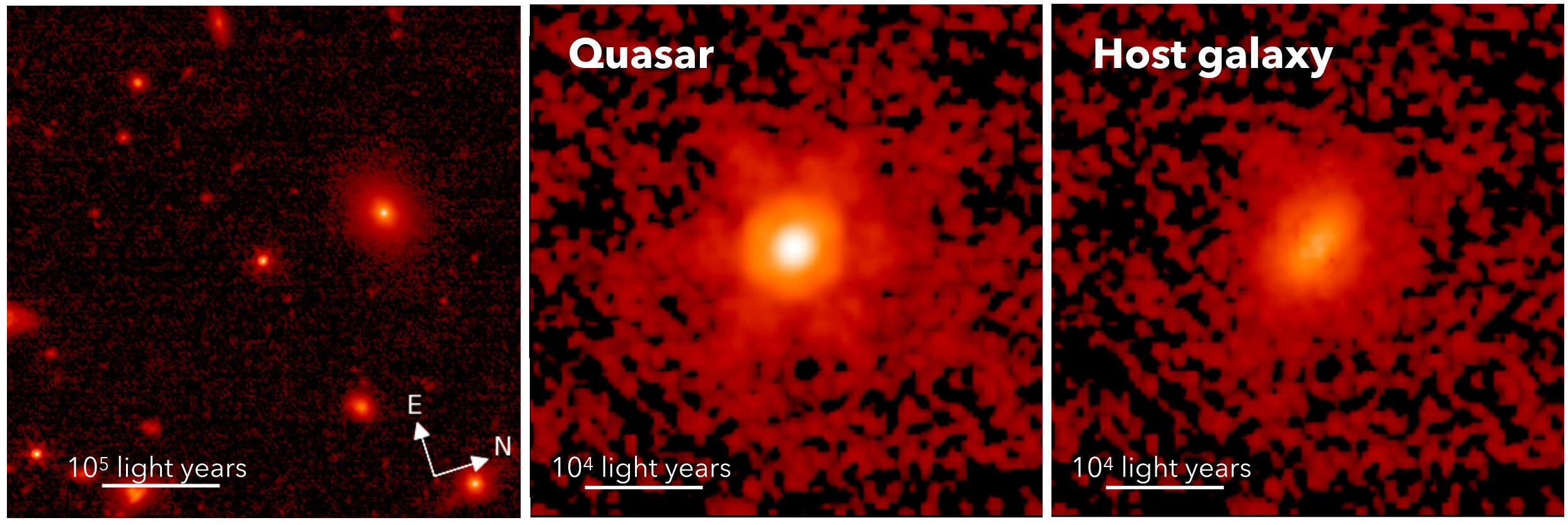New images from the James Webb Space Telescope (JWST) have revealed, for the first time, starlight from two massive galaxies hosting actively growing black holes – quasars – seen less than a billion years after the Big Bang. The two quasars were originally discovered by the Subaru Telescope's wide-field camera, HSC. The powerful combination of the Subaru Telescope and JWST has paved a new path to study the distant Universe.

Figure 1: The JWST images of HSC J2236+0032 include a zoom-out image (left), a quasar image (center), and the host galaxy image after subtracting the quasar light (right). Each panel shows the image scale in light years. (Credit: Ding, Onoue, Silverman et al.)
Astrophysicists are faced with perplexing questions regarding the presence of supermassive black holes in the early Universe. How could these black holes grow to be so large in a short time? Additionally, the correlation seen in the local Universe between the mass of supermassive black holes and the galaxies they inhabit, presents another mystery. The sizes of host galaxies are on a completely different scale than the sizes of the black holes. So do the host galaxies control the growth of their black holes or do the black holes dictate the growth of the host galaxies?
This is a "chicken-or-egg" problem on a cosmic scale.
An international team of researchers has started to answer this question by using JWST to inspect distant quasars found by HSC on the Subaru Telescope. Studying the relation between host galaxies and black holes in the early Universe allows scientists to watch their formation, and see how they are related to one another.
The team observed two quasars, HSC J2236+0032 and HSC J2255+0251, at redshifts 6.40 and 6.34 when the Universe was approximately 860 million years old (Note 1). The relatively low luminosities of these quasars made them prime targets for measurement of the host galaxy properties, and the successful detection of the hosts represents the earliest epoch to date at which starlight has been detected in a quasar.
From the observations, the team found that the ratio of the black hole mass to host galaxy mass is similar to those seen in the more recent Universe. The result suggests that the relationship between black holes and their hosts was already in place within the first billion years after the Big Bang.
"The Subaru HSC survey has been quite successful in finding more than 160 quasars in the early universe thanks to its unique combination of the wide survey area and the deep imaging. These HSC quasars are actually ideal targets for detecting starlight from host galaxies, because the radiation from the accreting black holes is relatively weaker than those of the other known quasars at the same distance," says Dr. Masafusa Onoue (Peking University Kavli Institute for Astronomy and Astrophysics), a key member of the research team. "I have been deeply involved in the HSC-SSP survey since my PhD years at NAOJ. I am extremely proud of the successful starlight detection from the HSC quasars that we found with Subaru."
The team will continue this study with a larger sample obtained from the HSC survey. These observations will constrain models for the coevolution of black holes and their host galaxies.
More details are available in a press release by the Kavli IPMU.
These results appeared as Ding, Onoue, Silverman et al. "Detection of stellar light from quasar host galaxies at z > 6" in Nature on June 28, 2023.
(Note 1) The distances to the objects are based on the cosmological parameters reported by the Planck satellite in 2013 (see "Expressing the distance to remote objects" on the NAOJ website).


